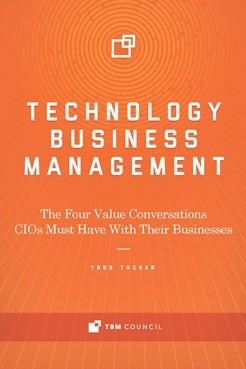Learn how TBM gives technology leaders and their business partners the facts they need to collaborate on business-aligned IT investment decisions.
Excerpted from Technology Business Management: The Four Value Conversations CIOs Must Have With Their Businesses, published by the Technology Business Management Council.
Technology Business Management (TBM) is a value-management framework instituted by CIOs, CTOs and other technology leaders. Founded on transparency of costs, consumption, and performance, TBM gives technology leaders and their business partners the facts they need to collaborate on business-aligned decisions. Those decisions span supply and demand to enable the financial and performance tradeoffs that are necessary to optimize run-the-business spending and accelerate business change. The framework is backed by a community of CIOs, CTOs and other business leaders on the Technology Business Management Council.
While TBM applies common business management practices to IT — ones that have defined the modern, data-driven enterprise — it also represents nothing less than a business revolution in IT. As Brian Adams, CIO of WorleyParsons put it, “TBM represents the first real change to the way IT is managed that’s occurred during my 25-year career. Everything else has been evolutionary; TBM is revolutionary.” Adam’s viewpoint and his passion for TBM, have been shaped by his somewhat unique perspective. His career actually spans roles far beyond IT, including CFO, strategy and development, marketing, product quality, and customer satisfaction.
IT is not the first domain to undergo a similar revolution. In the 1970s and the 1980s, manufacturers implemented a data-driven approach to optimize their supply chains from procurement through production. For the first time, they used technology to connect supply to demand, in turn reducing inventories, cutting production times, and improving margins. Manufacturing resource planning (MRP), as this method was known, led to new manufacturing techniques, such as just-in-time (JIT) inventories and total quality management (TQM). MRP was a game changer, and it gave birth to today’s enterprise resource planning (ERP) software.

Figure 1: Applying MRP and ERP, manufacturers used
technology and data to manage their supply chains
More recently, marketing departments have made similar changes. Just a decade ago, they were led by brand-savvy, creative leaders who made only gut-check decisions based on a knowledge of their products, buyers, and competitors. Marketing was a battle of wits, not data. Now, many chief marketing officers (CMOs) apply data to every aspect of their discipline. Using marketing automation tools and analytics, CMOs are working hard to connect every part of the marketing supply chain from website inquiries to qualified leads to active opportunities to closed deals. Many CMOs understand the conversion rates and costs at each stage of this supply chain, which they call the revenue engine. They continuously optimize that engine using data. Marketing is today quickly becoming as much science as it is art.

Figure 2: With marketing automation and CRM, CMOs use data to
manage and tune their revenue engines to improve corporate returns
It works the other way around too. By measuring conversion rates, CMOs now understand the total cost of generating a single deal, what they call their customer acquisition cost. They use these facts to create a practical plan and a defensible budget. If the business needs 20% more transactions (deals) next year, it will need to fund a sufficient number of inquiries and leads at a known (historical) cost. The CMO’s budget request is now based on a formula based on facts and figures, not educated guesses and/or long-held assumptions.
Managing the Supply and Demand of IT
Now it’s your turn. IT must use facts to answer important questions about its own supply chain: How are your resources (money, people, and time) spent to deliver towers of infrastructure and other technologies? How are those resources used to deliver projects? How are your towers cobbled together into applications and services? How are those apps and services consumed by your business partners to generate revenue and manage costs? If you can make these connections, you can make decisions that improve efficiency, grow return on capital, and add business value. Further, you can change the conversations you have with your business partners.

Figure 3: With TBM, CIOs manage the supply and demand of IT
As with the marketing supply chain, you can look at yours in reverse. You can see precisely how business demand drives the cost of your apps and services, and in turn, you can identify the consumption of infrastructure towers and resources. This is powerful information. Not only does it help you create a financial plan based on how resources are actually allocated and consumed, it connects everything your people do to business outcomes.
Early TBM Successes
It is no coincidence that the development of TBM was influenced by someone who understands firsthand the challenges of managing supply and demand. Rebecca Jacoby, SVP of Operations at Cisco, started her career in manufacturing and supply chain roles, and at one point she was responsible for the global consolidation of Cisco’s supply chain. After becoming CIO in 2006, she advocated a management approach that addressed both the supply of and the demand for IT. For Jacoby, this went beyond the supply-chain management for only IT. Instead, it would fundamentally change the conversations that she and her team were having with their business partners.
"At Cisco, we recognized that in order to drive business value and innovation, we had to become a competitive provider of IT services. This meant, among other things, that we had to change the very conversations we were having internally and with our business partners. Our conversations and our vocabulary needed to move beyond technologies, SLAs and projects, to discussions about the tradeoffs needed to balance cost, quality, and value. Only in doing so could we free up resources for business growth and strategic execution. These tradeoffs are at the core of Technology Business Management."
— Rebecca Jacoby
Jacoby went so far as to define those value conversations by setting standards for them. They included strategy alignments, IT portfolio planning, architectural reviews, and quarterly value discussions with stakeholders. They centered on value considerations — scope, source, architecture, quality of service, time to capability, risk — all balanced by a new dimension — cost. The result allowed her to align business and IT plans more closely, shape the portfolio of applications and services to meet the business’s needs better, tweak their technology stack to increase performance (even while reducing costs), and shape demand by putting a price tag on consumption. Now, as Chief Operating Officer, Jacoby is putting these practices to work beyond IT.
 Still, it’s not just former CFOs and supply chain leaders who are shaping TBM. Many CIOs who have spent a majority of their careers in IT also are putting their mark on TBM. Larry Godec has spent the majority of his career working in various IT roles — much of it as the CIO of First American, a leading provider of title insurance, settlement services, and risk solutions for real estate transactions.
Still, it’s not just former CFOs and supply chain leaders who are shaping TBM. Many CIOs who have spent a majority of their careers in IT also are putting their mark on TBM. Larry Godec has spent the majority of his career working in various IT roles — much of it as the CIO of First American, a leading provider of title insurance, settlement services, and risk solutions for real estate transactions.
In 2012, with the housing market starting to recover, Godec needed to shift his IT department to respond to the demands of a growing business. Godec recalls in great detail precisely when his TBM journey began — a budget meeting with his CEO Dennis Gilmore. “Dennis said, ‘We’re going to focus on growth.’ He told me I needed to know where we should be investing in customer-facing technology, because that’s what the business will need to compete.”
However, with a majority of his budget dedicated to supporting the existing IT estate, Godec needed to figure out how to shift resources quickly without putting the business at risk. He needed to see his resources in business terms, so he could collaborate with his CEO, CFO, and his line of business leaders on where to make the changes.
In a stroke of good timing, Godec heard what he needed to hear at a presentation by Tony Scott, then the CIO of Microsoft. “I was at Microsoft for a briefing by Tony when he showed this dashboard I had never seen. For the first time, I saw someone who put IT costs, resources, and investments into terms I could easily explain — by the applications and technologies that the business was using.”
Godec now saw the way to put everything he did into business terms. Godec’s first pass at TBM helped him create a simple portfolio view of the IT-business landscape, so he could have informed discussions about which apps and services were being consumed and by whom; how much he was spending on each of his major applications; and how much he needed to spend to support each line of business.
These facts led to several revelations about their portfolio. Many of the insights helped lead to cost reduction, while others led to the opposite conclusion. For example, by seeing for the first time the percentages of total spending on their app portfolio, they could justify increased investment in customer-facing technologies.
Other insights came in rapid succession, such as identifying end-of-life applications that were still consuming infrastructure and resources. In the end, these insights added up to significant budget savings and reallocations to more valuable purposes. Godec knew there were more, so he put his team on the hunt for new discoveries. His goal? Significantly reduce annual operating costs without reducing the quality of service and support. His team of only two people, mostly in their spare time, exceeded this goal in just a few months.
This is an important lesson. TBM isn’t necessary because IT is too expensive. Instead, it’s needed because your resources are in short supply. IT budgets of course never satisfy everything your business wants; but the real problem is that skilled people are hard to find and your business competitive clock is ticking faster and faster. You can’t afford to waste people or time. IT may represent less than a tenth of your business cost structure, but it is inextricably linked to your ability to compete, serve your customers, and reduce those business costs. Your IT capital must thus be invested wisely to create the most value.
Value is what TBM — this business revolution in IT — is all about.



Add a Comment